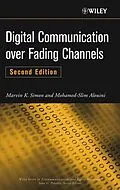The four short years since Digital Communication over Fading
Channels became an instant classic have seen a virtual explosion of
significant new work on the subject, both by the authors and by
numerous researchers around the world. Foremost among these is a
great deal of progress in the area of transmit diversity and
space-time coding and the associated multiple input-multiple output
(MIMO) channel. This new edition gathers these and other results,
previously scattered throughout numerous publications, into a
single convenient and informative volume.
Like its predecessor, this Second Edition discusses in detail
coherent and noncoherent communication systems as well as a large
variety of fading channel models typical of communication links
found in the real world. Coverage includes single- and multichannel
reception and, in the case of the latter, a large variety of
diversity types. The moment generating function (MGF)-based
approach for performance analysis, introduced by the authors in the
first edition and referred to in literally hundreds of
publications, still represents the backbone of the book's
presentation. Important features of this new edition include:
* An all-new, comprehensive chapter on transmit diversity,
space-time coding, and the MIMO channel, focusing on performance
evaluation
* Coverage of new and improved diversity schemes
* Performance analyses of previously known schemes in new and
different fading scenarios
* A new chapter on the outage probability of cellular mobile radio
systems
* A new chapter on the capacity of fading channels
* And much more
Digital Communication over Fading Channels, Second Edition is an
indispensable resource for graduate students, researchers
investigating these systems, and practicing engineers responsible
for evaluating their performance.
Autorentext
MARVIN K. SIMON, PhD, is Principal Scientist at the Jet Propulsion Laboratory, California Institute of Technology, Pasadena.
MOHAMED-SLIM ALOUINI, PhD, is Associate Professor in the Department of Electrical and Computer Engineering of the University of Minnesota, Minneapolis.
Klappentext
The four short years since Digital Communication over Fading Channels became an instant classic have seen a virtual explosion of significant new work on the subject, both by the authors and by numerous researchers around the world. Foremost among these is a great deal of progress in the area of transmit diversity and space-time coding and the associated multiple input–multiple output (MIMO) channel. This new edition gathers these and other results, previously scattered throughout numerous publications, into a single convenient and informative volume.
Like its predecessor, this Second Edition discusses in detail coherent and noncoherent communication systems as well as a large variety of fading channel models typical of communication links found in the real world. Coverage includes single- and multichannel reception and, in the case of the latter, a large variety of diversity types. The moment generating function (MGF)–based approach for performance analysis, introduced by the authors in the first edition and referred to in literally hundreds of publications, still represents the backbone of the book's presentation. Important features of this new edition include:
- An all-new, comprehensive chapter on transmit diversity, space-time coding, and the MIMO channel, focusing on performance evaluation
- Coverage of new and improved diversity schemes
- Performance analyses of previously known schemes in new and different fading scenarios
- A new chapter on the outage probability of cellular mobile radio systems
- A new chapter on the capacity of fading channels
- And much more
Digital Communication over Fading Channels, Second Edition is an indispensable resource for graduate students, researchers investigating these systems, and practicing engineers responsible for evaluating their performance.
Inhalt
Preface xxv
Nomenclature xxxi
Part 1 Fundamentals
Chapter 1 Introduction 3
1.1 System Performance Measures 4
1.1.1 Average Signal-to-Noise Ratio (SNR) 4
1.1.2 Outage Probability 5
1.1.3 Average Bit Error Probability (BEP) 6
1.1.4 Amount of Fading 12
1.1.5 Average Outage Duration 13
1.2 Conclusions 14
References 14
Chapter 2 Fading Channel Characterization and Modeling 17
2.1 Main Characteristics of Fading Channels 17
2.1.1 Envelope and Phase Fluctuations 17
2.1.2 Slow and Fast Fading 18
2.1.3 Frequency-Flat and Frequency-Selective Fading 18
2.2 Modeling of Flat-Fading Channels 19
2.2.1 Multipath Fading 20
2.2.1.1 Rayleigh 20
2.2.1.2 Nakagami-q (Hoyt) 22
2.2.1.3 Nakagami-n (Rice) 23
2.2.1.4 Nakagami-m 24
2.2.1.5 Weibull 25
2.2.1.6 Beckmann 28
2.2.1.7 Spherically-Invariant Random Process Model 30
2.2.2 Log-Normal Shadowing 32
2.2.3 Composite Multipath/Shadowing 33
2.2.3.1 Composite Gamma/Log-Normal Distribution 33
2.2.3.2 Suzuki Distribution 34
2.2.3.3 K Distribution 34
2.2.3.4 Rician Shadowed Distributions 36
2.2.4 Combined (Time-Shared) Shadowed/Unshadowed Fading 37
2.3 Modeling of Frequency-Selective Fading Channels 37
References 39
Chapter 3 Types of Communication 45
3.1 Ideal Coherent Detection 45
3.1.1 Multiple Amplitude-Shift-Keying (M-ASK) or Multiple Amplitude Modulation (M-AM) 47
3.1.2 Quadrature Amplitude-Shift-Keying (QASK) or Quadrature Amplitude Modulation (QAM) 48
3.1.3 M-ary Phase-Shift-Keying (M-PSK) 50
3.1.4 Differentially Encoded M-ary Phase-Shift-Keying (M-PSK) 53
3.1.4.1 /4-QPSK 54
3.1.5 Offset QPSK (OQPSK) or Staggered QPSK (sqpsk) 55
3.1.6 M-ary Frequency-Shift-Keying (M-FSK) 56
3.1.7 Minimum-Shift-Keying (MSK) 58
3.2 Nonideal Coherent Detection 62
3.3 Noncoherent Detection 66
3.4 Partially Coherent Detection 68
3.4.1 Conventional Detection 68
3.4.1.1 One-Symbol Observation 68
3.4.1.2 Multiple-Symbol Observation 69
3.4.2 Differentially Coherent Detection 71
3.4.2.1 M-ary Differential Phase-Shift-Keying (M-DPSK) 71
3.4.2.2 Conventional Detection (Two-Symbol Observation) 73
3.4.2.3 Multiple-Symbol Detection 76
3.4.3 /4-Differential QPSK (/4-DQPSK) 78
References 78
Part 2 Mathematical Tools
Chapter 4 Alternative Representations of Classical Functions 83
4.1 Gaussian Q-Function 84
4.1.1 One-Dimensional Case 84
4.1.2 Two-Dimensional Case 86
4.1.3 Other Forms for One- and Two-Dimensional Cases 88
4.1.4 Alternative Representations of Higher Powers of the Gaussian Q-Function 90
4.2 Marcum Q-Function 93
4.2.1 First-Order Marcum Q-Function 93
4.2.1.1 Upper and Lower Bounds 97
4.2.2 Generalized (mth-Order) Marcum Q-Function 100
4.2.2.1 Upper and Lower Bounds 105
4.3 The Nuttall Q-Function 113
4.4 Other Functions 117
References 119
Appendix 4A. Derivation of Eq. (4.2) 120
Chapter 5 Useful Expressions for Evaluating Average Error Probability Performance 123
5.1 Integrals Involving the Gaussian Q-Function 123
5.1.1 Rayleigh Fading Channel 125
5.1.2 Nakagami-q (Hoyt) Fading Channel 125
5.1.3 Nakagami-n (Rice) Fading Channel 126
5.1.4 Nakagami-m Fading Channel 126
5.1.5 Log-Normal Shadowing Channel 128
5.1.6 Composite Log-Normal Shadowing/Nakagami-m Fading Channel 128
5.2 Integrals Invo…
